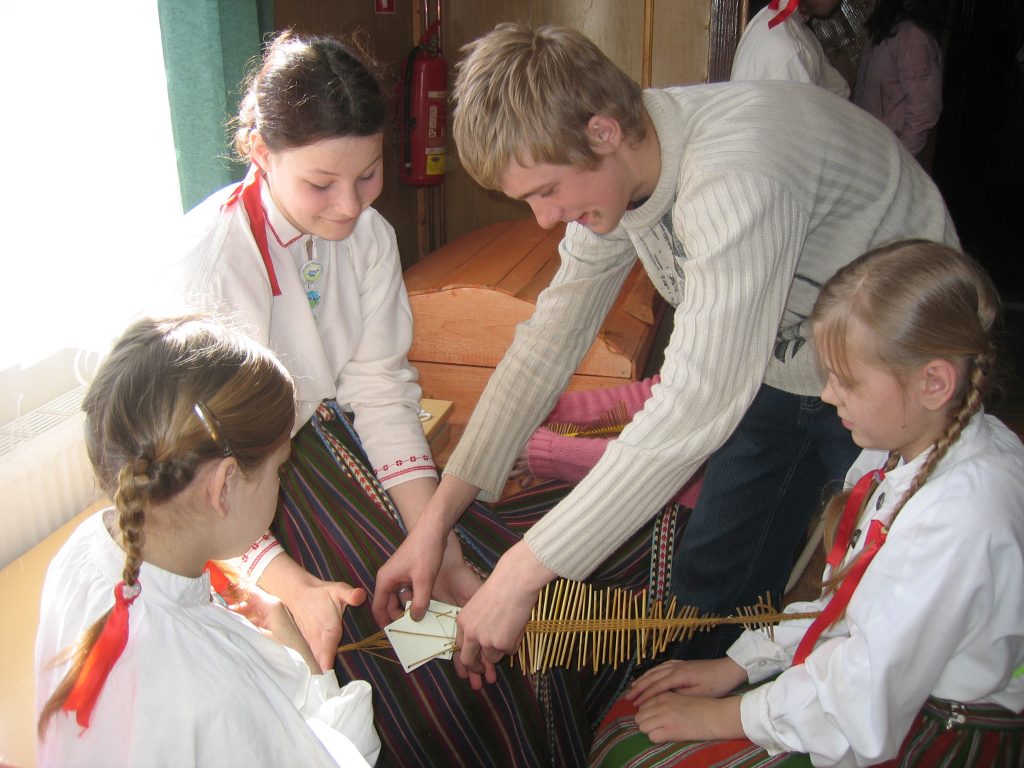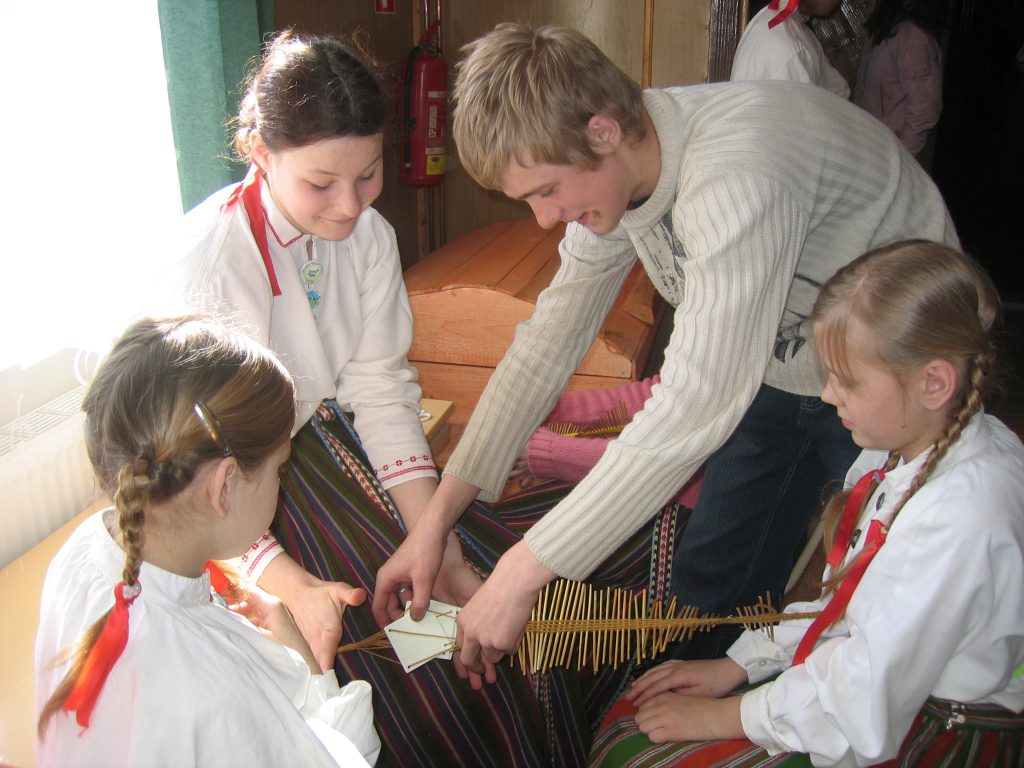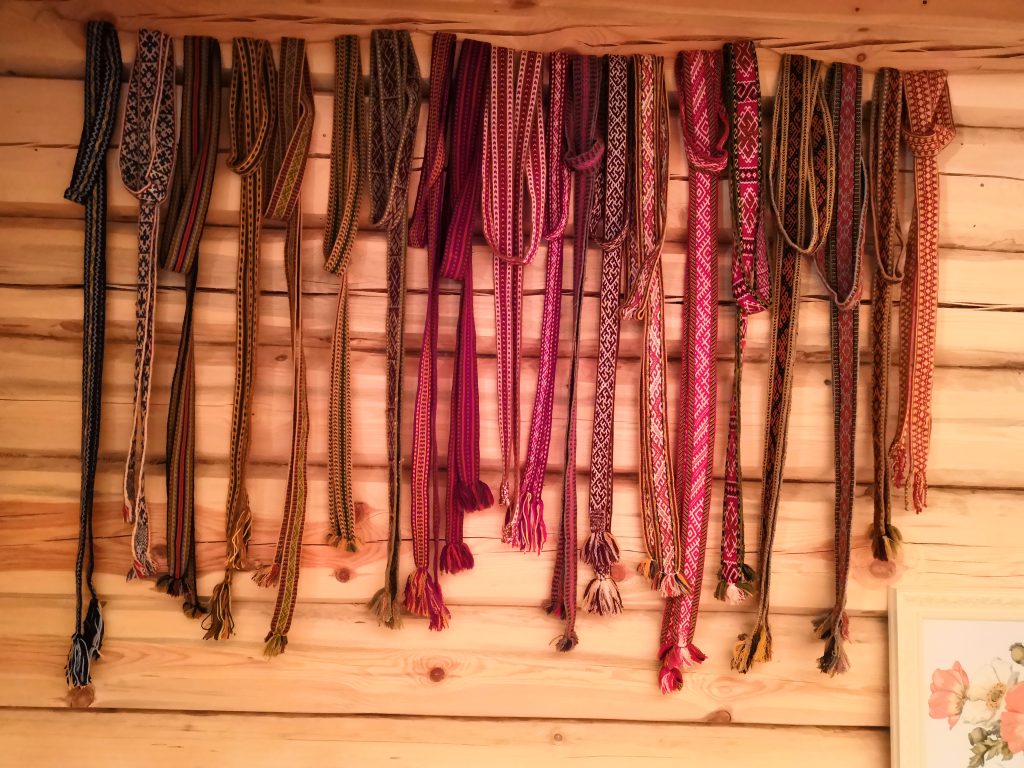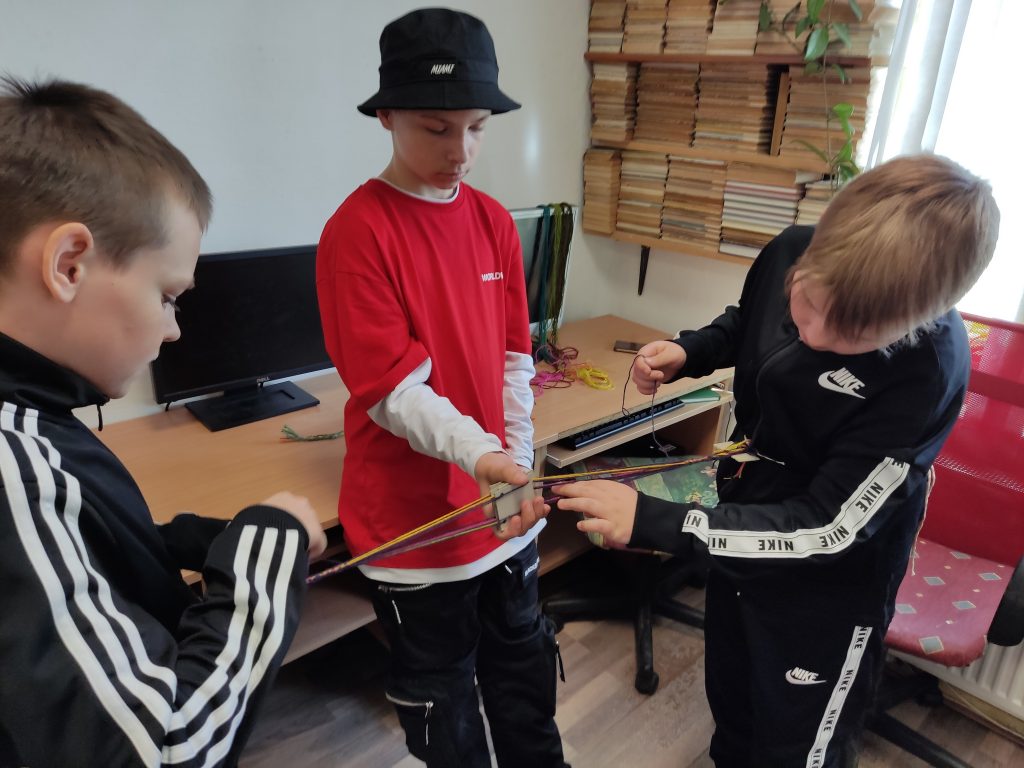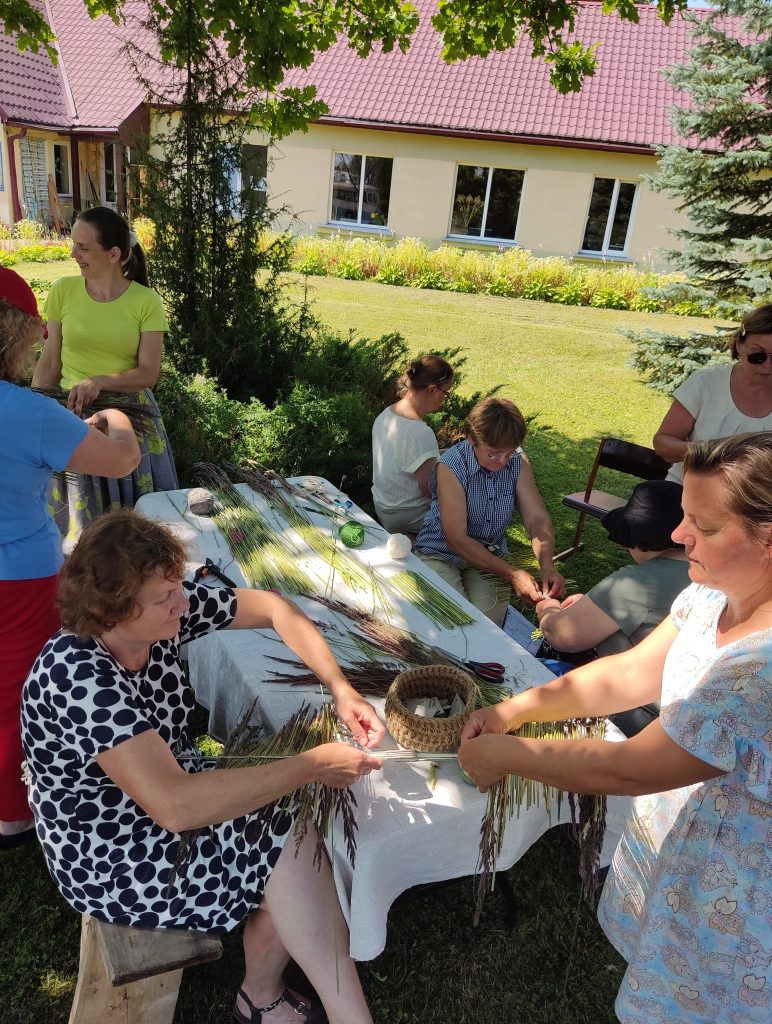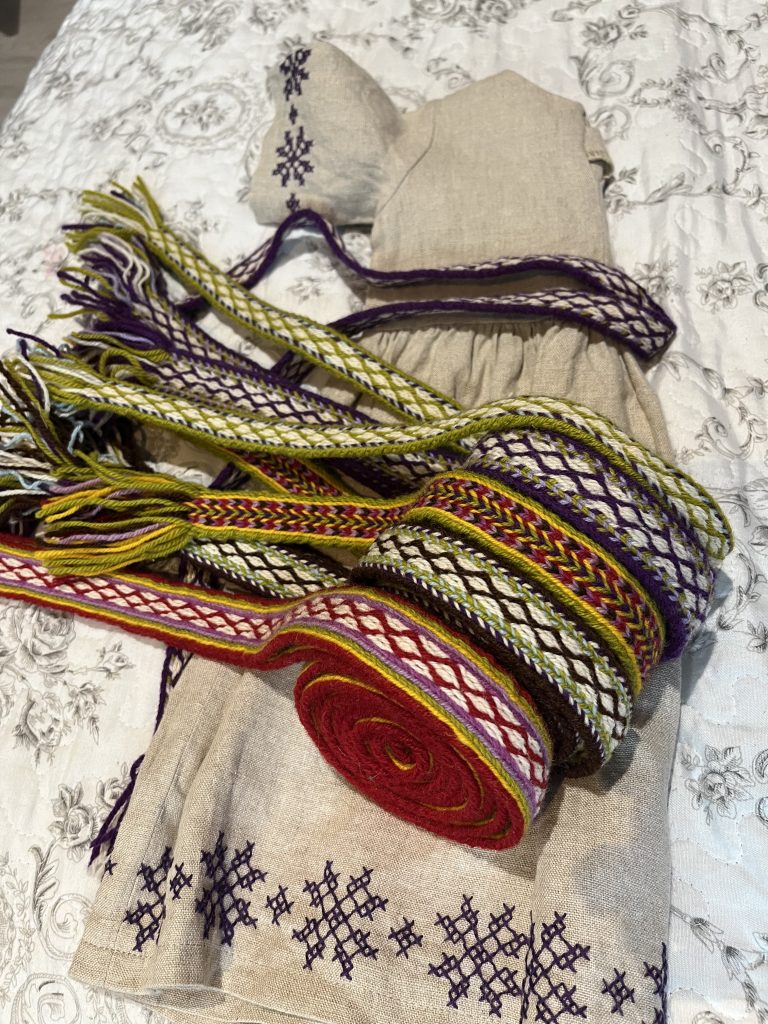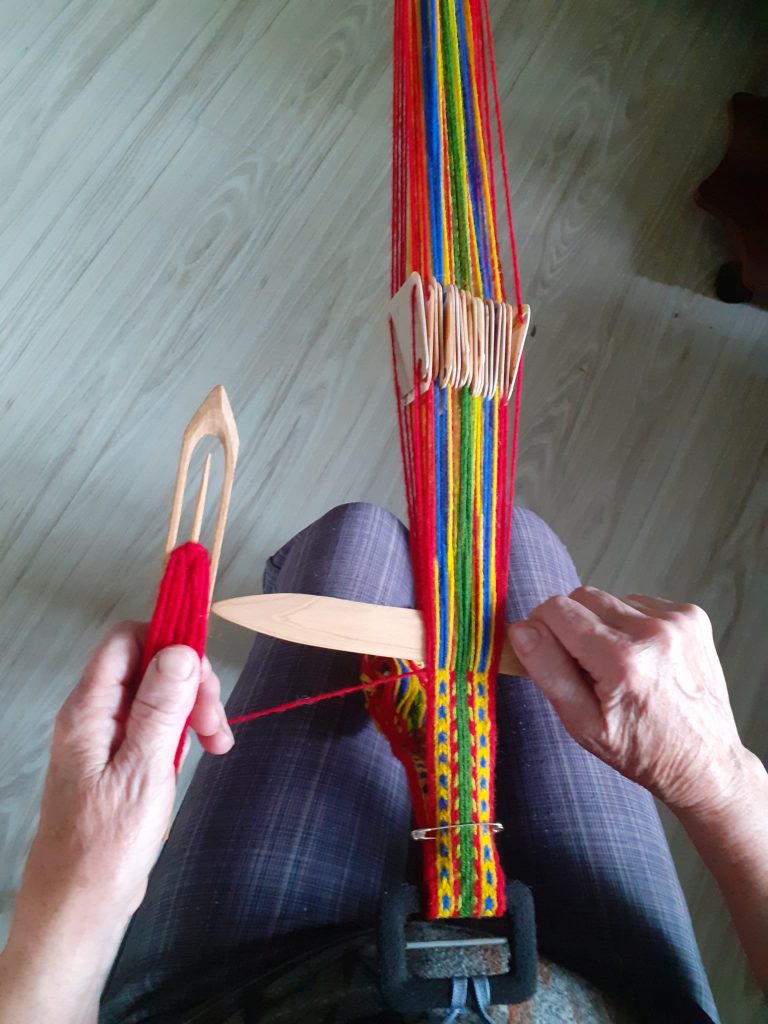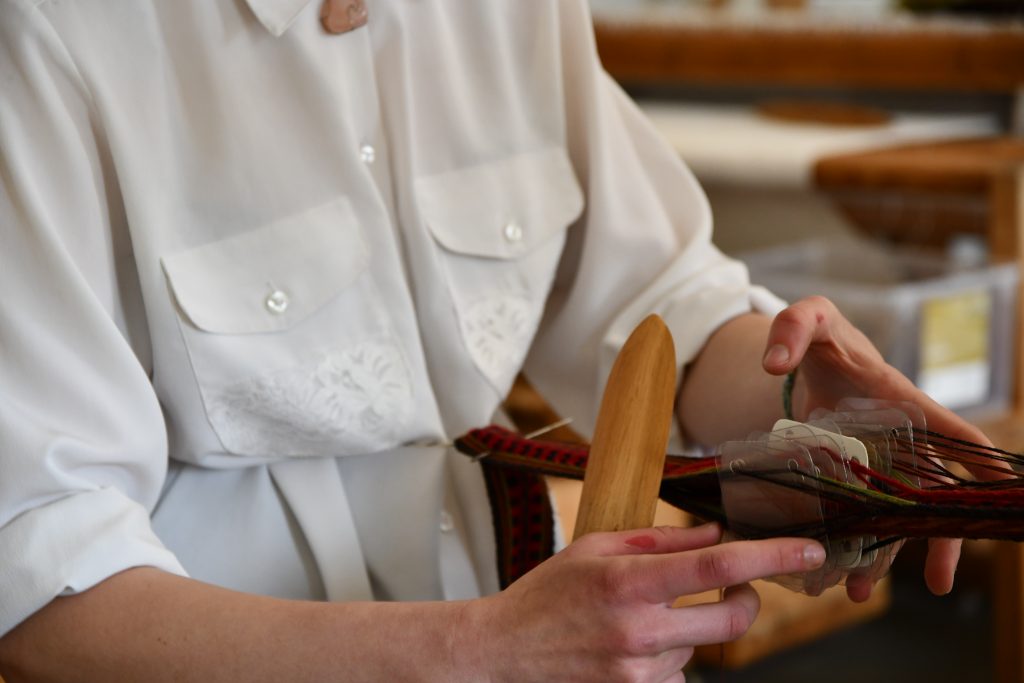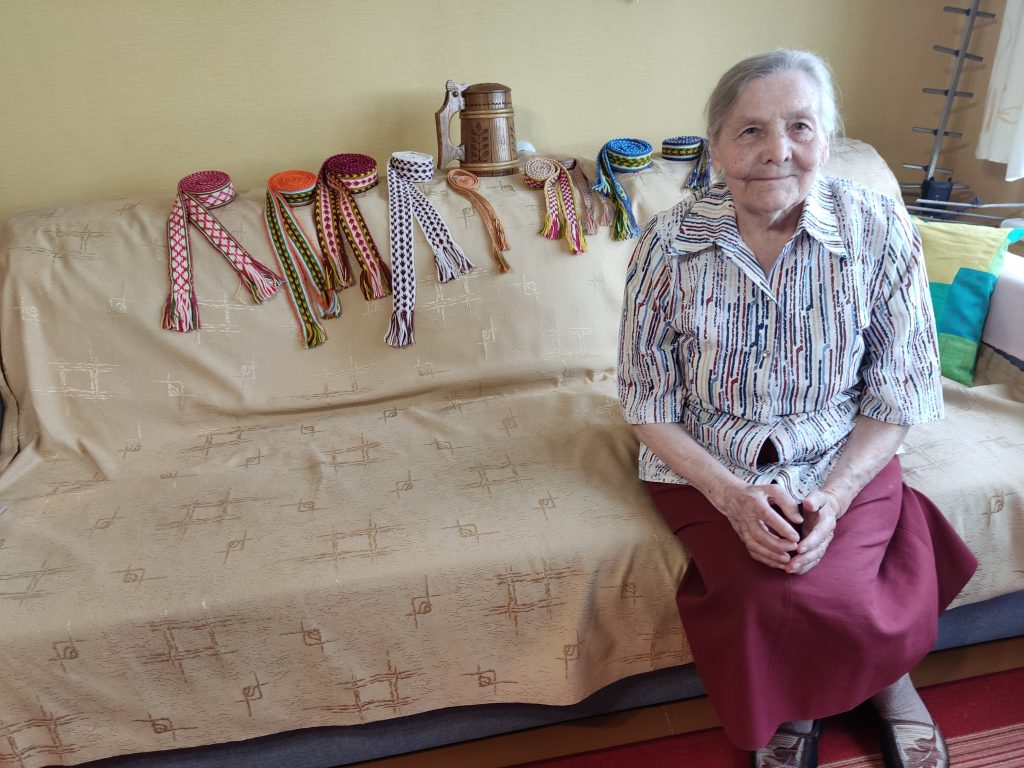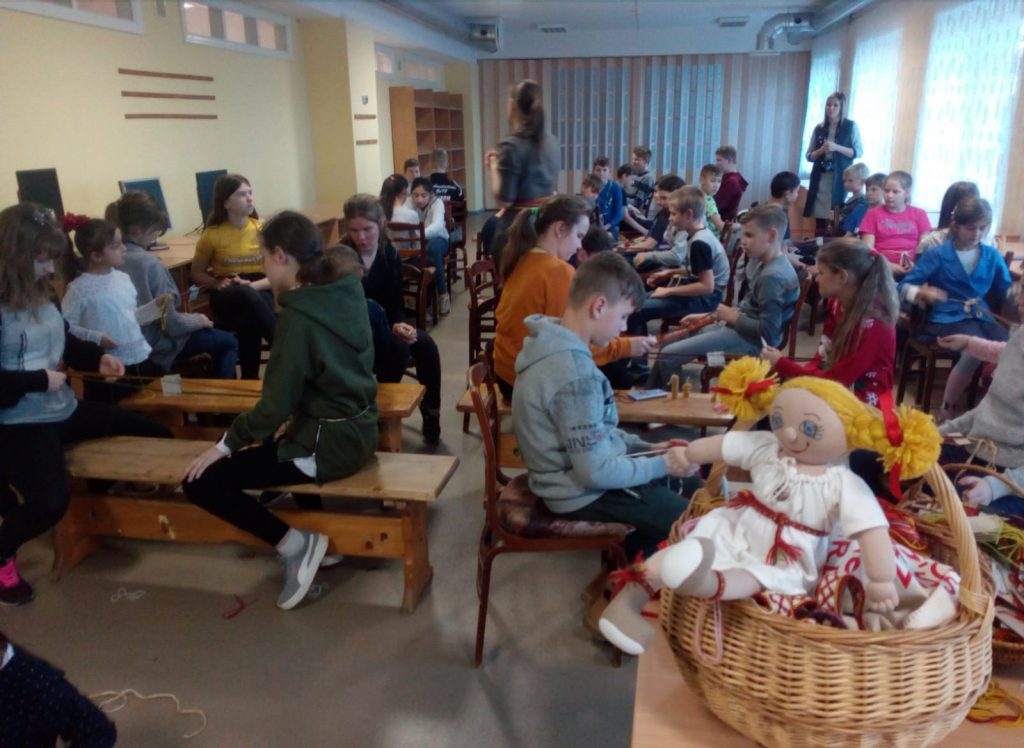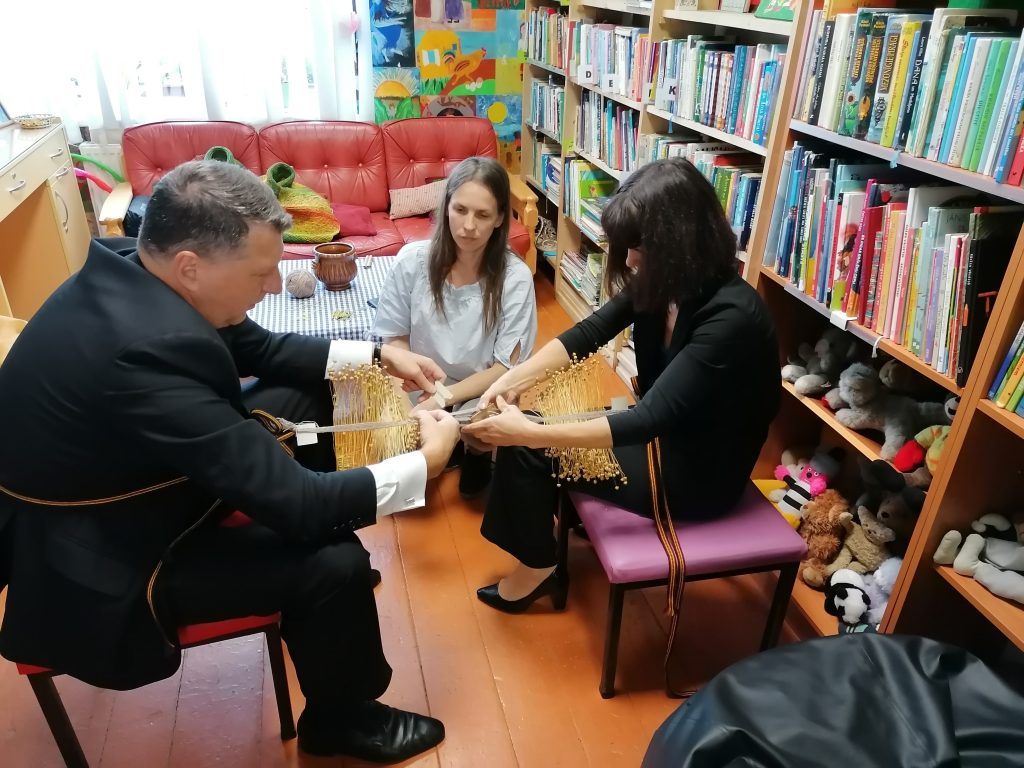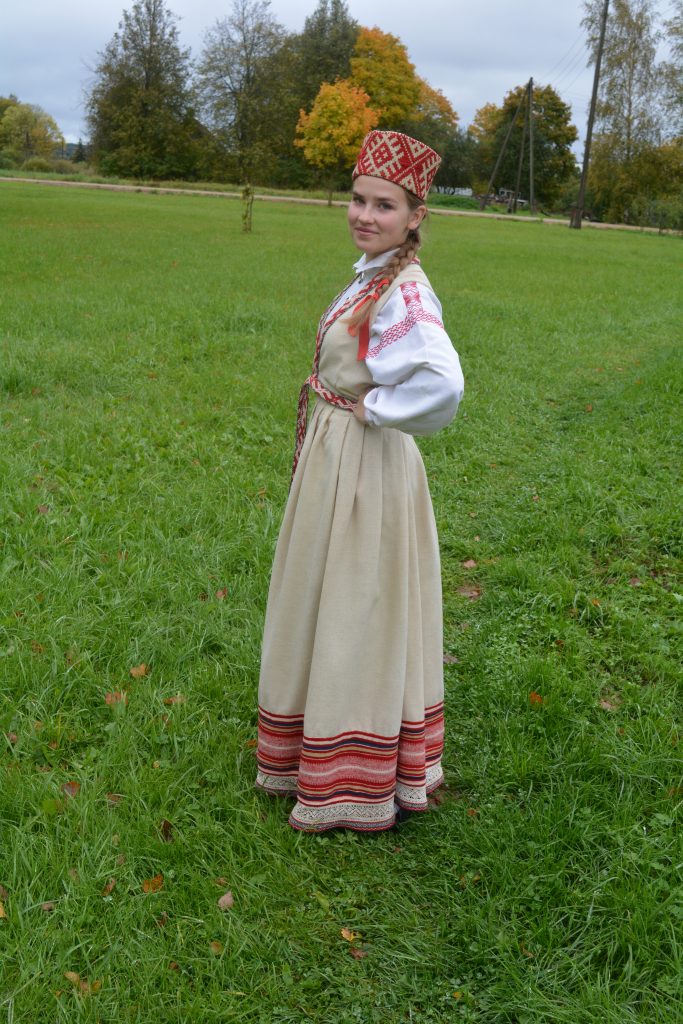Author:
Kate Slisans
Traditional craft skills
Title
Knee belt weaving tradition in North Latgale (2023)
Celu Ustine
Celaine
Knee shoe
Knee belt
The waistbands (knee belts, knees, knee shoes, knee handkerchiefs) have taken their name from knee tables – boards in which the tug threads in the weaving process change places along with the turns of the boards after each thread of woven fabric.
Geography
North Latgale, Latvia
Weaving a knee belt is an individual process where, in direct contact with materials, the weaver creates its own work. But the clusters, groups, or individuals associated with this element are not only masters, but also those who recognize, apply, and promote this element. They are therefore divided into the following groups of people:
1. Masters - knee belt weavers who apply weaving skills on a daily basis. Weaving for yourself, for sale, as well as being able to teach, tell others by passing on weaving skills. Most active weavers: Martha Gailum, Iveta Gabrien, Ligita Spridzane, Evita Zaremba-Kruger, Sindija Login and more;
2. Interests – people who are prepared to learn to weave knee belts by attending events related to this element, masterclasses. These individuals tend to be interested, communicate with and learn from those in the post in person, understanding the meaning of the element. These are most often primary school pupils in grades 4-9 who acquire building skills with their teachers;
3. People who have inherited cele belt stories from their relatives as well as received material from their heritage and know to tell others about them (see Annex: text materials, heritage stories);
4. People who understand the meaning of the knee belts that have gone to the master, picked their own Article, ordered it to be made in person for themselves. It is carried with honour to a folk suit, linen dress, etc. for various festivals, honours and events. Respect this element in order to emphasise and maintain their ethnic identity;
5. Belt carriers - members of folklore clusters, ethnographic ensembles, chapels and folk dance groups.
Importance in Community Life
People in North Latgale appreciate the importance of the cellaine, so in important family events and honours they choose to make a straight-up woven belt as a gift:
• at a wedding for newlyweds to keep a close hold and not let grief and misery into the new family;
• in the crossbones of the newborn, to bring strength and health to the child, to easily swallow and hold;
• at the funeral, the knee belt is given to the deceased to protect his soul.
North Latgale folklore clusters, ethnographic ensembles, chapels, as well as folk dance collectives are very active folk costume wearers, so there is also a need for new celebs: both by knee belts and by knee shoes.
Activities/Actions
The cele boards are 2-3 mm thick squares with 6-8 cm sides and one hole at a time in each corner. The easiest thing to do is work on cele boards, which have thicker midrides but thinner edges.
To weave with knee tables, you need:
(a) two rigid strings, one to tie the ends of the tows to a stationary object, the other to tie the ends of the other tows to the waist or to another stationary object;
(b) a wooden knife, the edges of the blades of which are straight and blunt, or a small ruler designed to shift the tissue; some masters do not use a knife, but twist the tissue thread and tap it with a finger;
(c) the bundle on which the tissue thread is wound;
C) yarns: wool yarns were traditionally used, but now flax yarns, various cotton yarns – spools, toffee, crochet yarns, mulliness yarns, etc. are used.
Knee weaving technique is a combination of cord cutting, twisting and weaving. Put one warp (hair) thread into the hole of each knee board and turn the knee forward or backward, depending on the weaving pattern. A cord-like twist forms. The warp threads on the elevator tables change places in the weaving process, twisting with the turn of the boards.
For the patterned cellanes, the warp thread is only seen in two holes along the diagonal, where one thread is written in colour and the other in base colour.
One of the four twisted yarns is not yet a knee fabric. The knee fabric is formed when several such strings are combined with tissue thread.
In North Latgale, celestial tables are called celestial diesels.
The knee can be woven by cutting the boards in different directions. In North Latgale, turning away from herself, says – against the colon, turning on itself – now the colon.
Celu Yostina is made up of warp/threads called hair germ in North Latgale and thread that is pierced into tissue germ.
In North Latgale, the shaved pattern is called sleeve weaving.
Beliefs, Rituals, Unwritten Rules
The choice of women's and men's belt patterns, as well as how they are worn, is different.
Men's clothing usually wears less patterned belts, striped and shaved tracks.
Latgale has specific belt volume techniques – by folding the ends of the belt behind the wrap, as well as creating a node-free loop.
Men strap the belt to the folk's gown for the better, leaving no long ends of belts that would howl along the sides or braid on their feet, while women strap to the left, leaving long ends of the belt.
Beliefs.
If a belt is woven for a special occasion, then use absolutely all the veins (wolves) only for the belt, that is, weaving nothing from start to finish and leaving no leftovers, it will bring happiness to the belt recipient.
When weaving a belt, the weaver puts in his positive emotions, his good thoughts, so the belt has more power.
Inheritance and Transfer
The best way is to meet the masters face-to-face.
The “meet your Master!” project, where masters in freestyle hold masterclasses, individual classes, open workshops, lectures, lectures on the skill in question. In it, the knee-belt weaving skills are further betrayed by masters: Ligita Spridzane in the River, Evita Zaremba-Kruger in Briejuziema, Iveta Gabrane in Tilge, Eliza pundit in the Balvos.
Ligita Spridzane is active and passionate about promoting knee-belt weaving skills. The Ontons Slisans River Museum of cultural History has created the museum pedagogical programme “weaving of North Latgale knee belts”, where any interested person can learn the skills of weaving knee belts. Both group and individual classes are available.
Masterclasses and the museum pedagogy program are mostly attended by primary school students in grades 4-9. They come into groups (about 30 participants). Boys and girls all learn the basics of knee-belt weaving by choosing their own colour compositions and patterns. Usually, garters are woven striped or with small cones. It is very popular to construct ceiling decorations – tissue-woven natural materials that form swirls
On the opening day of their exhibitions, Evita Zaremba-Kruger and Anita Zaremba offered face-to-face dating and masterclass-building.
Remote options.
in 2022, the Northlatgale knee belt weaving video Guide was created in the summer, which can be found on the website of the river culture room in the “Search for Master” section, available at: https://www.upite.lv/meklejam-meistaru/ (broadcast 3 - in fact, the occasional Helen Slisans guoja Muocien will be woven by Ligita Sprizanes, master of pains.)
History
Weaving belts in knee technology in Latvia is a very ancient type of handicraft, as evidenced by the still primitive fragments of knee shoes found in archaeological excavations from the 6 th century (see Annex: text materials, knee shoes). The most luxurious fragments of knee belts or celestial trees came from the Latvian and Lebanese populated territories of the 11 th-13 th century.
Based on archaeological excavations found in the ancient tombs of Danilovka, the earliest woven paths in Skilbeni Parish can date back to the 11 th-14 th century. Celaines were written, both with the Article read and the Article woven without reading. There were wreaths with shaved roads woven into the ends of the pendants (see Annex: text materials, shaved cellane). The characteristic colours of the patterned cellanes sewn to the edges of the tartan villas are blue and reddish, red-brown and blue yarn in the edges. The blue-tongued villain with woven strips of bronze/rings also has cellanes in similar colours.
Not only has the tradition of saggy footwear remained in the northern latgale, but also the adornment of brunch edges with footwear in the Abrene area (see Annex: text materials, luxurious cellanes). Here you can talk about millennia-old traditions, where the pattern of the edges of a knee shoe is not symmetrical.
Striped and shaved cellaines have been used throughout Latgale – both as women's and men's belts. Over time, the fineness and tone of the yarn used to make them changed for the cellanes. Later-made cellanes are very bright.
Traditions of wearing and using woven belts are very old. Belts and garters donated the house to the spirits. With belts, the Latvian virgin and wife secured their brunches, embellished sagging edges, brunch and jacket edges, girded coats, tied aprons, tied socks and stalks. Baby cradles were hung in the knee belts. They were also horse harness things, reins and leashes. Bundles, burdens, sieved with belts and garters. They were used wherever you needed to tie something.
As time goes on and clothing cuts and closures change, belts are used not so much for practical need but more to make clothes more glamorous, so the belts had a mostly adorning function. The belt also played a symbolic role, it was like a symbol of good virtue and virtue. This is evidenced by the Latvian scenes:
Struggling feelings,
Pedar condemns loudly;
Girls in a handkerchief with a mouthful,
The Padar girls call out.
At the ancient Latgalian villaine, knee shoes have been a mandatory ingredient, but already at the villains of the ethnographic garment of North Latgale, knee shoes are not present.
Once a celelaine has served to strengthen the bottom of the brunches (work, casual clothes), then decorate (festive clothes). At the moment, the belt serves as an important element of the countrysuit, or as a decoration of stylized festive clothing.
In the past, the cellaines used to weave cradle hangers and reins because there was at least one horse on each fence. The beautiful reins were for the holidays or festivals to come, but now few fences have a horse. Nor did children sleep more in cradles, but in modern cribs, so knee belts aren't used to hang a cradle.
Nowadays, a popular celelaine, with smells woven into the tissue, straw or flax with all the buttons, serves as a decoration, an environmental object, an outdoor element as a whirlwind, and inside as a ceiling decor.
For a moment, cele weaving traditions began to fade, while now a trend has emerged for forgotten traditions to start learning anew: preserving, nurturing, refining and also transforming, as all traditions of the nation must be judged by time distance, means they are variable.
Creativity in tradition.
Wife of the River ethnographic ensemble in the 20 th century. in the 80 s, they made Abrene outfits for themselves (inspired by Mary Leishman's (1925-2021) homemade Abrene folk outfit), self-weaving her brunch-bottomed knee shoes and waistbands. Weaving the belts created a new type of Abrene's belts - a creation by Helen Shakin that was specifically designed for Abrene's outfit.
Starting in the 20 th century. in the early 80 s, master Irene Slisans revived weaving in a knee technique. in the 21 st century it is continued by master Ligita Spridzane, mainly creating ceiling decorations and Christmas decorations made of straw, smelly or flax straw with all the buttons. Weaving them into a knee technique creates very beautiful elements of style and design.
Andris Slisans in the 20 th century. in the 90 s, Rivers elementary School, led by Irene Slisans learned the technique of building. Irene also taught how to weave canvases in woven letters, Andris fascinated by the idea. She figured out, independently, how to weave words into the roads, and she realized it as a surprise to her teacher, Irene, for example, weaved in the words “Uppite,” “Riga.”
In 2019, Evita Zaremba-Kruger examined the building fabrics of the ethnography department of the national Museum of History of Latvia found in the territory of the then Vilák municipality (formerly in the parishes of Vilaka and Skilbeni). Celaines described and later weaved off their replicas.
Three belts are kept from Vilaka Parish at the national Museum of History of Latvia, 8 belts and 13 more garlands from the Parish of Squilbines from both parishes, as well as one example of white Abrene brunch shoes from Vilaka and Squilbines. According to the description in the book – ELGA Kivicka, Adolfa Karnup “Municipality costumes, Jaunlatgale, Lielvarde, VII”. Riga: Latvian workers' Union, 1990 - also found one Baltinava side knee belt.
In terms of colour as a whole, in northern latgales, celaines cannot be called uniform, shades of red and purple predominate. It's not hard to suspect that the designer colours of the celestial originals chose not only to their own taste but also to their own. As an example, a belt from Vilaka Parish, Svilpova, in which the symmetry of colour stripes is mixed with brown and maroon; it is apparent that some yarn has been missed by the weaver. Evita imitates the tissue in the same way (see Annex: text materials, Swhistpova Celine).
Special articles can be talked about in the context of footwear. Skilbeni Danilovka villainy shoes are ornate in patterns, the belts and garters are longitudinally striped and shaved. There are signs of Yumiah, a comb pattern, in the brunch shoe from Vilaka. In the case of a skinny shoe, a firescript and a comb pattern (see Annex: text materials, brunch shoes).
In North Latgale, the oldest celestial planks that have been preserved in heritage from ancestors are made from thin, well-worked wood, but in the 20 th century. in the 80 s, cele boards are made primarily of thin, white or blue-green plastic.
Later, the masters began experimenting with knee-board materials, and each master has its own knee-board-making path. Some inherit boards from the family, others from family members help make them. All sorts of ways are being trialled to find the most convenient version of the celestial boards for yourself: old credit cards or telecards have also been used, adapting the cele to the shape of the board. They are also made from ice cream “Excellency” box lids or thick dense cardboard.
Masters
1. Martha Gailuma, stubble (1955)
2. Anita Zaremba, Vilaka (1969)
3. Iveta Gabrien, Baltinava (1974)
4. Ligita Spridzane, Uppite (1979)
5. Andris Slisans, Uppite (1981)
6. Evita Zaremba-Kruger, Vilaka (1991)
7. Eliza pundit, Balvi (2001)
8. Sindija Login, Uppite (2001)
9. Helen Slisans, Uppite (2012)
Institutions and Organizations
• Society “River Youth Folklore Community”
• Intangible cultural Heritage Centre “Uppite”
• “River School” – a folk-wear workshop is gradually being created
• Baltinava School of music and Art
• Baltinava High School
• Baltinava Parish Museum
• Baltinava Culture House
• Awards County Museum
• Women's society “waterrose”
Strengthening the Tradition
• From 1980 to 2015, Irene Slisans has actively managed a knee belt weaving workshop at the River primary School, a folklore festival in the river, as well as a festival of various cities and parishes in North Latgale;
• in 2006, Ligita Spridzane restored the archaeological knee belt of the ancient tombs of Danilovka on a sample;
• in 2007, Ligita Spridzane was in a knee belt weaving masterclass at Helena Shakin in Anchipova with Grade 8 of Rekawa High School;
• In cooperation with the State Culture capital Foundation from 2009 to 2010, “Abrene costume Revival workshops” took place in several stages. Iveta Gabrane and members of the gallop of Baltinava High School carried out research work at the national Museum of History of Latvia, performed replicas, shared workshops with the experience gained, presented the project at conferences and seminars. Construction phase: on 5 September 2009, seminar – workshop “techniques and materials developed in the weaving of Abrene's garment” in the People's House of Briejuziema;
• on November 26, 2011, the presentation of the project “Abrene outfit Revival Workshop” was held at the conference “North Latgale readings I”, manager Iveta Gabrane;
in 2011, Ligita Spridzane, in cooperation with the Education, Culture and Sport Board of Vilakas county Council, led the masterclasses “weaving of North Latgale knee belts” in the people's house of the river. It was attended by girls from the Vilaka Culture House Dance collective, pupils from the River primary School and members of the Folklore ensemble “uptake”;
• in 2011, the project “audz, Latgale!” was implemented in stubble with several masterclasses of ancient positions. In Iveta Gabrien's masterclass, it was possible to learn weaving from the ground up;
• Yvette Gabrien, Head of the Save not to lose Project Iveta workshops (2013-2014);
• Evita Zaremba-Kruger Creative Workshop in the weaving of knee belts at the Vilakas county Festival on July 13, 2014;
• Exhibition “Balttour” by Evita Zaremba-Kruger and Anita Zaremba and meeting with masters, Riga in 2015;
• At the IV International Folk Dance Festival “Eims, EIMA” Iveta Gabrane led a masterclass on North Latgale folk costume, its traditions of wearing it in 2016;
• Evita Zaremba-Kruger masterclass in knee belt weaving at Verschukaln on July 7, 2017;
• Evita Zaremba-Kruger and Anita Zaremba's exhibition “rainbow of Celotus belts” and opportunity to try weaving without looms, Awards CB in children's literature Division February 26, 2018;
• on April 6, 2018, Iveta Gabrane, as part of the “meet your Master” project at Tilja High School with children, weaved a belt and talked about the North Latgale folk outfit;
• Evita Zaremba-Kruger exhibition “measuring time” in Vilnius and Geelong from May 4 to July 13, 2018;
• “Meet your Master” masterclasses with Ligita Spridzan in early April 2019, which taught celebs and garlands weaving;
• Exhibition by Evita Zaremba-Kruger and Anita Zaremba and a knee belt weaving workshop on July 26, 2019, Anna day in Vershukaln;
• in December 2021, a career education event was held for the grades of Rekawa, Vilaka, Medieval and Geelong primary School, where Ligita Spridzane taught knee weaving to more than a hundred children in one day.
• Starting in 2022, master Ligita Spridzane regularly runs the museum pedagogy program “weaving North Latgale knee belts” at the Ontons Slisans River Museum of cultural History. More than 50 lessons have been completed during this period, with an average of 8 to 14 participants participating in each;
• Martha Gailum exhibition at stubble Library in 2022;
• Martha Gailuma has participated in co-exhibitions in Baltinawa, the Awards Museum and the Prize Central Library with her works, but has not recorded specific years;
• as part of “meet your Master,” on March 31, 2023, Eliza Pundures's narrative of the countrysuit-making experience. Preparation of braided garter following the early 20 th century model “young — young”. The prize at the municipality museum;
• as part of “meet your Master” in early April 2023, Evita Zaremba-Kruger taught her how to build in the Briezuciems People's House.
Online video guide:
For Maclay, the Master - broadcast 3 - is built by the Utastines. Where Ligita Spridzane tells the story of knee belts and teaches Helen Slisans the process of casting and weaving.
Thanks to a 2011 masterclass with Ligita Spridzan, the skills of knee belt craft could be acquired by primary school-aged children who were very excited by it. Many of them snapped up more than one belt. Kate Slisans, for example, remembers her first belt being audible in her favourite colours of the time, which were pink, lilac, later finding out more about the importance of the celebs decided to take off the belt in traditional shades she wears until today at her folk suit. Salvis Logins, on the other hand, wore his cut-off belt until the last day he was a Member of the folklore ensemble “Uppite,” currently keeps it as a big treasure.
As well as a very good example, Sindija Login, who became interested in handicrafts thanks to the possibility of masterclasses. And right now there's a master of knee belts who can pass that tradition on to future generations.
It is possible to weave off your first belt yourself, as well as if there is more interest and willingness to meet the video master – Ligita Spridzan – by contacting him and meeting him face-to-face for a private lesson.
After a 2013 lesson with Ligita Spridzan, Evita Zaremba-Kruger and Anita Kruger restored their knowledge in building and have now become celeb belt masters.
As part of the “meet your Master” project, Martha Gailum, taught by Yvette Gabrien, learned a knee weaving technique and is now the master herself who can teach others.
• Right now, the weaving of the knee belts is based on the enthusiasm of the masters themselves, they do so for their own pleasure and mostly for themselves. Accept orders and are glad to be able to pass on their works in tangible form as well as their skills in oral and practice form. The biggest support for them is from family and close people;
• In collaboration with the State Culture capital Foundation, a series of “Meklay Masters” was achieved about the weaving of knee belts. Master – Ligita Spridzane, video operator, editing – Kate Slisans;
• In co-operation with the State Culture Capitala Foundation and the national cultural Centre of Latvia, workshops “making of North Latgale countryside” were organised, which included master workshops in relation to construction, which was managed by Iveta Gabrane;
• Ontons Slisans River Museum of cultural History has established a museum pedagogy program called “knee belt weaving,” which is supported by the prize municipality municipality. Classes are taught by Ligita Spridzane;
• Carpenter Wilhelm Laganovsky has designed and specially designed knee belt weaving looms for Ligita Spridzane, which are easy to place and portable. It is possible to weave a belt between one and six metres in length in these looms.
Continuity/Development
1. Kate Slisans, a technician of intangible cultural heritage at the Centre for intangible cultural Heritage of the municipality of Awards, will decipher the interviews with the masters of the knee belts and place them in storage for the Ontons Slisans Museum of cultural History;
2. Ligita Spridzane, head/keeper of the Museum of cultural History of the Onton Slichane River, will create descriptions of the knee belt weaving masters and implement them on the upite.lv/meistari website;
3. The masters Ligita Spridzane and Evita Zaremba-Kruger, together with Kati Slisans will create traditional technical drawings and video guides of the northern Latgale roads and will be published on the upite.lv website;
The Centre for intangible cultural Heritage Uppite is a guarantor of value, but the celestial masters live in different places in North Latgale. Any of the masters can be approached and will be able to teach knee belt weaving technique. It's a shame that the older, known master of knee-belt weaving in North Latgale - Helen Shakin (1961-2023) has just gone to eternity, which formed a firm foundation for this element.
• To participate in the “meet your Master” project, where to organise meetings with weavers of North Latgale knee belts, where the masters transfer their knowledge to visitors to the project;
• To submit to the initiative “School satchel of Latvia” an excursion lesson in schools “Halloween”;
• To organise the thematic exhibitions of the various heads of the North Latgale masters together at the intangible cultural Heritage Centre “Upte”;
• To organise symposia of textile artists with an emphasis on knowledge of building techniques and creation;
• Kate Slisans, an intangible cultural heritage technician at the Centre for intangible cultural Heritage of the District of Awards, will create a series of “Meklay Masters,” in which he will be told and instructed how to create a ceiling decoration in a building technique.
Update, inform and promote the knee belt weaving technique as much as possible, drawing interest from people who may not have heard of it at all. Inherit and pass on the skills of the masters, thus attracting the young generation who can carry and pass on the tradition in the future.
Threats to the Tradition
Unfortunately, there are too few masters who know how to make knee belts, so it takes an even more active and widespread promotion of knee-belt weaving skills to attract new leads to inherit celeb weaving traditions.
Maintaining knee-belt weaving skills is similarly endangered as any of the other craft skills that require manual labor to be invested in learning and preserving.
It is not properly assessed, the long time of making the item encourages the buyer to choose other ways of purchasing the item, receive it as soon as possible and at the lowest possible price, without added value.
Often the craftsmen themselves underestimate themselves and their work. It is not possible to set prices correctly without earning a fee.
If the prestige of hand-work is not built, the motivated young generation through masterclasses, workshops, lectures, demonstrations, then interest and knowledge of knee-belt weaving will shrink especially among young people, as priorities change as the years go by, everyone aspires to something more modern and simple that doesn't take much time and patience.
Applicant
Society “Folklore Community of young People of the River”, Kate Slisans, mastermind of intangible cultural Heritage Centre “Upte”
Gallery
Audio Materials
Video Materials
Text materials
Publications
Apine Herman, Anita. Weaving techniques in Latvia. Riga: Star on ABC, 2020.
Balhead-Treimane, Lily. Weaving of belts and shoes. Riga: SIA “Jelgava printing house”, 2018.
Cranberry, Alexander and Treimanis, Lily. Latvian belts. Riga: Star, 1993.
Grassman, Maruta. Costumes of the Latvian people. Articles. Embroidery. Riga: RAS ABC, 2000.
Ivanova, G. and Madris, I. belt patterns. Riga: flame, 1968.
Jansons, Aye and Carlson, Annette. Advice to Latvian folk costume wearers. exercise Book 2. Riga: v/a TMC, 2003.
Kulakova, Maya. Weaving of garters and belts. Experimental learning medium. Lielvarde: Lielvarde, 1994.
Costumes of the Latvian people. volume 3. Zemgale, upper country, Latgale. Riga: Jana seta, 2003.
Knife, rule. Housekeeping. My sister's belt was woven. Riga: Star on ABC, 1998.
Knife, Valija. Belts and garters. Riga: Star on ABC, 2012.
Paegle, Edouard. Celelaine. Exile, 1951.
Radina, Arnis. Archaeological guide in Latvian and Latvian history. Riga: Neptun, 2012.
Bomb, Ligita. Research into the weaving traditions of the native North Latgale municipality and acquisition of belt weaving techniques in Class 8 in household and technology. Riga, 2007.
Zarina, Anne. Ancient Latgalian clothing. Riga: Science, 1970.
North Latgale readings I. Edition of the Awards Municipality Museum, 2012.
Jeire, Irita. Archaeological outfit. Making, wearing and assembling it in modern Latvia. Riga: Latvian national Centre for Culture, 2017.
Websites
For Maclay, Master - broadcast 3 - build the Ustines “Ligita Spridzan tells me about the knee straps and teaches Helen Slisans the process of throwing and weaving knees. This material is for people who want to learn how to weave a knee belt through self-study. It may be possible to contact the master himself and arrange individual counselling/classes.
Folk-wear stories - This section shows the stories of various folk costumes, includes the tales of Abrene folk costume of the Awards County Museum and Abrene folk costume of the Ontons Slisans River Museum of cultural History.
Weaving - This section provides information about the prize district's weavers, among whom are women in the knee-belt weaving profession, such as Iveta Gabrien, Martha Gailum and Ligita Spridzane.
Masters - in this section, you can get information about the various masters of the riverside cultural space positions, such as Helen Shakin and Ligita Spridzan.
Maclay Master - in this section, you can find demo videos of various skills in the post, among them a video of knee belt weaving.
Masters Card - You can check out the masters and scenes of “meet your Master” workshops on this map. These include masterclasses by Eliza Pundures and Iveta Gabrien, for example.

